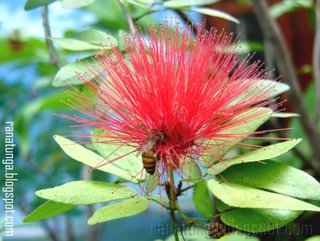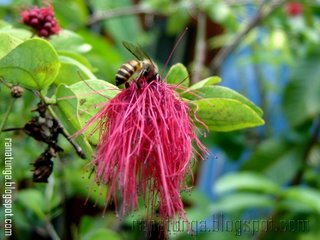Today morning I saw these bees busy at work. Got some really beautiful photos of them.
I just thought of reading more on them & found some very interesting facts...

Busy at work |
Bee Facts:
- Belong to genus Apis
- Have been producing honey for at least 100 million years.
- Have 4 wings, 5 eyes & fly at an average of 13-15 mph.
- Stroke wings 13,800 beats/minute, thus making a distinctive buzz.
- Produce beeswax from 8 paired glands on the underside of their abdomen.
- Honey is created when bees mix plant nectar with their own enzymes & then evaporate it by fanning their wings.
- Honey contains about 17.1% water, 38.5% Fructose, 31.0% Glucose & Maltose, Sucrose and other complex carbohydrates.
- Honey supplies 2 stages of energy, Glucose is absorbed quickly & gives an immediate energy boost & Fructose is absorbed more slowly providing sustained energy.
- Average hive temperature of 33ºC is maintained even if the outside temperature is 43ºC or -40ºC.
- A colony contains one queen, 500 to 1,000 drones and about 30,000 to 60,000 workers.
- Worker bees live for about 28 to 35 days
- Bees have an unusual genetic sex determination system, haplodiploidy. Workers are produced from fertilized eggs and have a double set of chromosomes. The males, or drones, develop from unfertilized eggs and are thus haploid with only a single set of chromosomes.
- Queen may mate with up to 17 drones over a 1-2 day period of mating flights & stores the sperm in her spermatheca, thus she has a lifetime supply and never mates again.
- Queen bees live for 2 to 5 years.
- Queens will lay almost 2000 eggs/day.
- Queen bees mandibular gland produces a pheromone, called queen substance, which workers lick from the queen's body and pass along. It inhibits the ovaries of workers.
- When the bee stings, the stinger, poison sac and several others parts are torn from the bee's body to be left on the victim & it will soon die.
- Bees communicate using Dance language & consists of a dance in a circle, for indicating sources & a tail-wagging dance in which the exact distance is indicated by a number of straight runs with abdominal wagging, fewer the runs per minute, farther away the source.
|
 |

Hovering near a flower, just before landing on it... |

Bees still busy at work,
even after the flowers had withered
away in the hot sun |
 |












